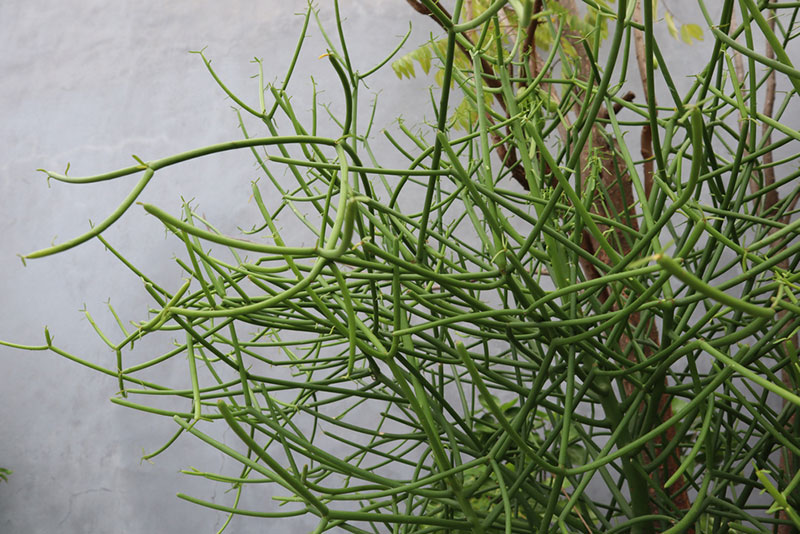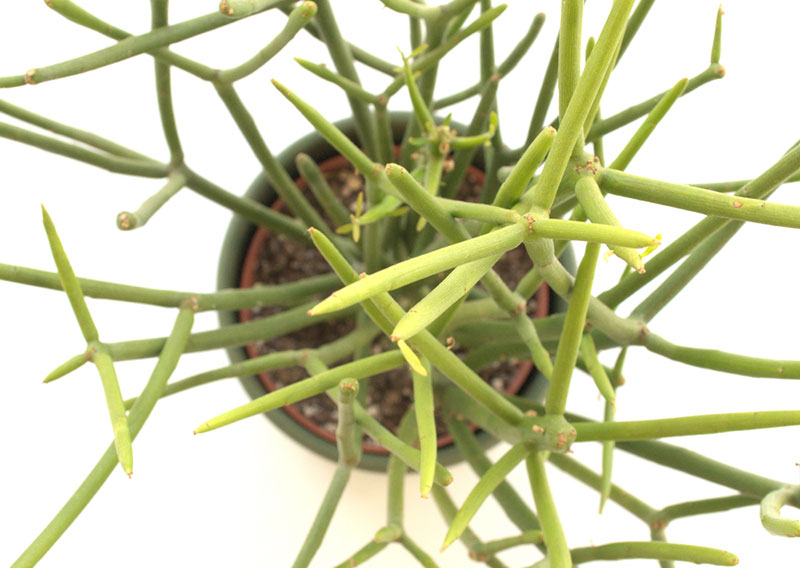
The pencil cactus (Euphorbia ‘tirucalli’) is a unique houseplant with its brown branches that branch out to smaller green branches and finally with 1-inch oval leaves. It gets its name from the fact that the branches resemble a pencil in both shape and size.
This plant can make a dramatic statement in your home, but it doesn’t come without some risks. The pencil cactus is toxic to both humans and animals and must be grown out of the reach of small children and pets.
Light and Temperature Requirements
The pencil cactus requires bright light and does best in full sun for at least 6 to 8 hours a day. Grow you pencil cactus in a southern or western window where it can receive full day sun for the best results. While it can survive in less light, growth will be slower and its health may suffer.
Pencil cactus prefers temperatures between 65 and 75 degrees and will suffer in temperatures below 50 degrees. It is sensitive to temperature changes and will suffer from either hot or cold drafts. Avoid growing your pencil cactus near drafty windows and keep it a safe distance from vents from the AC or heater.
Pencil cactus prefers low humidity levels, but will survive in normal household conditions. Avoid growing pencil cactus in the bathroom or kitchen or other areas where the humidity is high. If your home in humid, consider using a dehumidifier near your pencil cactus.
Watering
The pencil cactus does not like wet or soggy soil and will suffer from over watering. Water your pencil cactus thoroughly and allow the soil to dry out before watering it again. During the summer months when it is actively growing this may mean watering it every two weeks, depending on the plant size and the container it is grown in.
Reduce watering to once a month during the fall and winter when growth slows.
Soil & Fertilizing
The pencil cactus needs gritty soil that drains well to thrive. Regular potting soil is too dense for the pencil cactus. Use a potting mix designed for cactus and succulents or make your own by mixing equal portions of all-purpose potting soil, perlite and builder’s sand. This makes a loose, gritty soil that your pencil cactus will love.
Pencil cactus are not heavy feeders and do not require regular applications of fertilizer. They do, however, benefit from an application of fertilizer in the spring when new growth begins. Use a balanced fertilizer, such as 10-10-10, or purchase fertilizer designed for cactus and succulents.Apply the fertilizer when you water your pencil cactus.

Deadheading and Pruning
Old branches can be removed or trimmed to maintain size and improve the appearance of your pencil cactus at any time of year. But, exercise caution when trimming this plant. The stems exude a milky sap that is toxic. The sap does not need to be ingested to pose a danger, as it can also be absorbed through the skin and often causes skin irritations on contact.
Always wear gloves and protective clothing when working with a pencil cactus.
Propagation
Propagating a pencil cactus from cuttings is straightforward and relatively simple. Here’s what you need to know.
- Wear gloves and protective clothing when making cuttings for rooting new pencil cactus plants.
- Cut a 6-inch section of a green stem.
- Dip the end of the stem into cold water for a few seconds. This will stop the flow of sap from the end of the stem.
- Place the cuttings in a cool, dry place to dry for 5 to 6 days. This will cause the end of the cutting to form a callus, preparing it for rooting.
- Insert the cuttings into a pot or tray of moist cactus potting mix.
- Place them in bright, indirect light and keep the soil slightly moist until roots form in a week or two.
- Pot the cuttings in their permanent container once the roots are established, and you see signs of new growth.
- Resume normal care.
Special Concerns (Toxic)
The pencil cactus is an attractive plant that adds texture and a splash of nature to office spaces or even the home. However, the stems and leaves of this plant are toxic to both animals and humans. If you have small children or pets in your home it may not be worth the risk to grow a pencil cactus as a houseplant.
If you choose to add a pencil cactus to your living space make sure it is out of the reach of children and pets as accidental contact or ingestion can come with serious consequences. Watch for these signs of poisoning from a pencil cactus.
- Skin irritation such as burns, rashes and blistering from contact with the milky sap.
- Gastrointestinal distress such as upset stomach, diarrhea and vomiting.
- Ingesting large amounts of the plant (or its sap) can be fatal.




